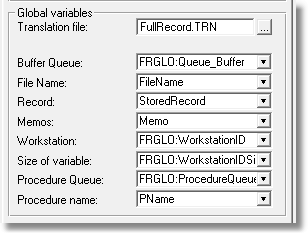"Global" Tab - Advanced Settings

The "Global variables" area refers to the global data area in your DCT and APP.
Translation file: The "translation file" is a text file where you store all the translatable messages to the user (See Translation options). If you don't include a path (like in this example), Clarion's RED file is used to locate the file.
Buffer Queue: The "Buffer Queue" global variable is the global queue which is going to store the buffer for saving the last record read for each file. As such, the queue have to contain one entry per file, with the filename, the record itself and the "memo" fields. These variables have to be declared in your DCT.
Memos: The "Memos" field will record the last memos accessed. As it is not possible to define a global variable as type memo, this field needs to be defined as a STRING. Due to the fact that you may have several memo fields in any file, this field should be Dimensioned. The dimension setting needs to be equal to the maximum number of memos that you may have in a single file. This may be difficult to calculate if you have a great number of Files. To simplify this task, we provide you with the TXD Analyzer companion program (See Using TXD Analyzer and Inform Largest Record), this program calculates the number you have to put into the dimension field for you.
If you still want to calculate the number manually, follow these guidelines.
For example: say you have the following files;
A: contains no memo fields
B: contains memo1 of 5000 bytes, and memo2 of 3000 bytes.
C: contains memo1 of 8000 bytes.
D: contains memo1 of 800 bytes, memo2 of 3600 bytes and memo3 of 1200 bytes.
From the example above, the "memos" variable should be Dimensioned to a value of 3 (file D contains the highest number of memo fields) and 8000 bytes long (the biggest memo field as in file C).
Workstation: The "Workstation" variable will hold the computer name where the audit operation took place. This variable will be populated by an API call and as such, it has to be declared as a CSTRING(256) in your DCT. If you don't want to store the workstation name where the audit operation took place, leave this entry blank.
Size of variable: The "Size of variable" variable will hold the size of the Workstation variable for the API call. It should be a type LONG variable. If you completed a Workstation variable, you should define this variable as well.
Procedure Queue and Procedure name: The "Procedure Queue" and "Procedure name" variables will be used to store the name of the current procedure in memory. The "Procedure name" variable should be a STRING and it should be large enough to store your longest procedure name. The "Procedure Queue" has to be declared as THREADED, otherwise it will fail to correctly register the name of the procedure when you open several windows at the same time.
You can change these names to any valid name you desire, or you can accept the defaults.